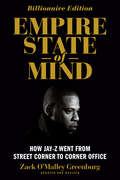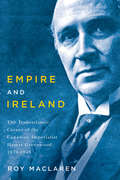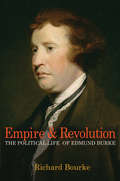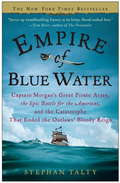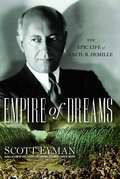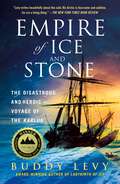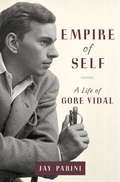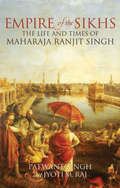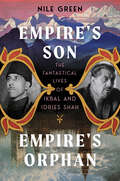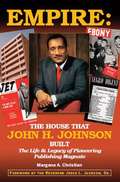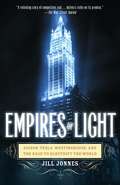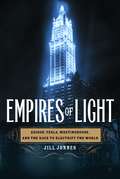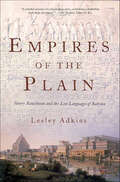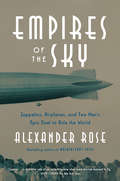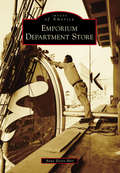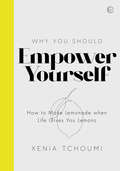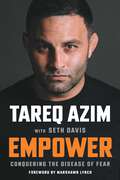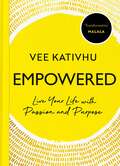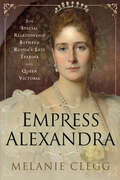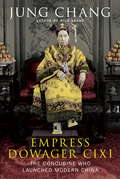- Table View
- List View
Empire State of Mind: How Jay Z Went from Street Corner to Corner Office, Revised Edition
by Steve Forbes Zack O'Malley Greenburg"I'm not a businessman-I'm a business, man." --Jay-Z Some people think Jay-Z is just another rapper. Others see him as just another celebrity/mega-star. The reality is, no matter what you think Jay-Z is, he first and foremost a business. And as much as Martha Stewart or Oprah, he has turned himself into a lifestyle. You can wake up to the local radio station playing Jay-Z's latest hit, spritz yourself with his 9IX cologne, slip on a pair of his Rocawear jeans, lace up your Reebok S. Carter sneakers, catch a Nets basketball game in the afternoon, and grab dinner at The Spotted Pig before heading to an evening performance of the Jay-Z-backed Broadway musical Fela! and a nightcap at his 40/40 Club. He'll profit at every turn of your day. But despite Jay-Z's success, there are still many Americans whose impressions of him are foggy, outdated, or downright incorrect. Surprisingly to many, he honed his business philosophy not at a fancy B school, but on the streets of Brooklyn, New York and beyond as a drug dealer in the 1980s. Empire State of Mind tells the story behind Jay-Z's rise to the top as told by the people who lived it with him- from classmates at Brooklyn's George Westinghouse High School; to the childhood friend who got him into the drug trade; to the DJ who convinced him to stop dealing and focus on music. This book explains just how Jay-Z propelled himself from the bleak streets of Brooklyn to the heights of the business world. Zack O'Malley Greenburg draws on his one-on-one interviews with hip-hop luminaries such as DJ Clark Kent, Questlove of The Roots, Damon Dash, Fred "Fab 5 Freddy" Brathwaite, MC Serch; NBA stars Jamal Crawford and Sebastian Telfair; and recording industry executives including Craig Kallman, CEO of Atlantic Records. He also includes new information on Jay-Z's various business dealings, such as: *The feature movie about Jay-Z and his first basketball team that was filmed by Fab 5 Freddy in 2003 but never released. *The Jay-Z branded Jeep that was scrapped just before going into production. *The real story behind his association with Armand de Brignac champagne. *The financial ramifications of his marriage to Beyonce. Jay-Z's tale is compelling not just because of his celebrity, but because it embodies the rags-to-riches American dream and is a model for any entrepreneur looking to build a commercial empire.
Empire and Ireland: The Transatlantic Career of the Canadian Imperialist Hamar Greenwood, 1870-1948
by Roy MaclarenIn Empire and Ireland, Roy MacLaren recounts the life and political career of Hamar Greenwood, a young man from rural Canada who reached the imperial pinnacle of the British cabinet. Greenwood’s arduous route was first beset by conservative opposition to his liberal convictions and later by hostility towards his role as chief secretary for Ireland under British prime minister Lloyd George during the tumultuous years of 1920 to 1922. A long-time advocate of Home Rule for Ireland, Greenwood endeavoured to provide Ireland with the same Dominion status as Canada. Dominion Home Rule, however, was not enough for Irish Republicans, who blamed him for the "Black and Tan” reprisals carried out by the British, and too much for Conservative Unionists, who believed he was insufficiently hard line. Eventually abandoning the divided Liberals for the Conservatives, he entered the House of Lords as Viscount Greenwood. By then Britain could no longer sustain an empire which, in his eyes, had been a cradle for justice, liberty, and development. The first biography of Hamar Greenwood, MacLaren’s thought-provoking work also illuminates the meaning of liberal imperialism, a significant factor in political thinking and policy formation throughout the global empire in Greenwood’s time, which still has resonance today.
Empire and Ireland: The Transatlantic Career of the Canadian Imperialist Hamar Greenwood, 1870–1948
by Roy MacLarenIn Empire and Ireland, Roy MacLaren recounts the life and political career of Hamar Greenwood, a young man from rural Canada who reached the imperial pinnacle of the British cabinet. Greenwood’s arduous route was first beset by conservative opposition to his liberal convictions and later by hostility towards his role as chief secretary for Ireland under British prime minister Lloyd George during the tumultuous years of 1920 to 1922. A long-time advocate of Home Rule for Ireland, Greenwood endeavoured to provide Ireland with the same Dominion status as Canada. Dominion Home Rule, however, was not enough for Irish Republicans, who blamed him for the “Black and Tan” reprisals carried out by the British, and too much for Conservative Unionists, who believed he was insufficiently hard line. Eventually abandoning the divided Liberals for the Conservatives, he entered the House of Lords as Viscount Greenwood. By then Britain could no longer sustain an empire which, in his eyes, had been a cradle for justice, liberty, and development. The first biography of Hamar Greenwood, MacLaren’s thought-provoking work also illuminates the meaning of liberal imperialism, a significant factor in political thinking and policy formation throughout the global empire in Greenwood’s time, which still has resonance today.
Empire and Revolution
by Richard BourkeEdmund Burke (1730-97) lived during one of the most extraordinary periods of world history. He grappled with the significance of the British Empire in India, fought for reconciliation with the American colonies, and was a vocal critic of national policy during three European wars. He also advocated reform in Britain, pressed for constitutional change in Ireland, and became a central protagonist in the great debate on the French Revolution. Drawing on the complete range of printed and manuscript sources, Empire and Revolution offers a vivid reconstruction of the major concerns of this outstanding statesman, orator, and philosopher.In restoring Burke to his original political and intellectual context, this book strips away the accumulated distortions that have marked the reception of his ideas. In the process, it overturns the conventional picture of a partisan of tradition against progress. In place of the image of a backward-looking opponent of popular rights, it presents a multifaceted portrait of one of the most captivating figures in eighteenth-century life and thought. While Burke was a passionately energetic statesman, he was also a deeply original thinker. Empire and Revolution depicts him as a philosopher-in-action who evaluated the political realities of the day through the lens of Enlightenment thought, variously drawing on the ideas of such figures as Montesquieu, Rousseau, and Hume.A boldly ambitious work of scholarship, this book challenges us to rethink the legacy of Burke and the turbulent era in which he played so pivotal a role.
Empire of Blue Water: Captain Morgan's Great Pirate Army, the Epic Battle for the Americas, and the Catastrophe That Ended the Outlaws' Bloody Reign
by Stephan TaltyHenry Morgan, a twenty-year-old Welshman, arrived in the New World in 1655, hell-bent on making his fortune. Over the next three decades, his exploits in the Caribbean in the service of the English became legend. His daring attacks on the mighty Spanish Empire on land and sea changed the fates of kings and queens. His victories helped shape the destiny of the New World. Morgan gathered disaffected English and European sailors and soldiers, hard-bitten adventurers, runaway slaves, cutthroats and sociopaths and turned them into the fiercest and most feared army in the Western Hemisphere. Sailing out from the English stronghold of Port Royal, Jamaica, 'the wickedest city in the New World', Morgan and his men terrorised Spanish merchant ships and devastated the cities where great riches in silver, gold, and gems lay waiting to be sent to the King of Spain. His last raid, a daring assault on the fabled city of Panama, helped break Spain's solitary hold on the New World for ever. Awash with bloody battles, political intrigues, and a cast of characters more compelling, bizarre and memorable than any found in a Hollywood swashbuckler, EMPIRE OF BLUE WATER brilliantly re-creates the passions and the violence of the age of exploration and empire. What's more, it chillingly depicts the apocalyptic natural disaster that finally ended the pirates' dominion.
Empire of Dreams: The Epic Life of Cecil B. DeMille
by Scott EymanBEST KNOWN AS THE DIRECTOR of such spectacular films as The Ten Commandments and King of Kings, Cecil B. DeMille lived a life as epic as any of his cinematic masterpieces. As a child DeMille learned the Bible from his father, a theology student and playwright who introduced Cecil and his older brother, William, to the theater. Tutored by impresario David Belasco, DeMille discovered how audiences responded to showmanship: sets, lights, costumes, etc. He took this knowledge with him to Los Angeles in 1913, where he became one of the movie pioneers, in partnership with Jesse Lasky and Lasky’s brother-in-law Samuel Goldfish (later Goldwyn). Working out of a barn on streets fragrant with orange blossom and pepper trees, the Lasky company turned out a string of successful silents, most of them directed by DeMille, who became one of the biggest names of the silent era. With films such as The Squaw Man, Brewster’s Millions, Joan the Woman, and Don’t Change Your Husband, he was the creative backbone of what would become Paramount Studios. In 1923 he filmed his first version of The Ten Commandments and later a second biblical epic, King of Kings, both enormous box-office successes. Although his reputation rests largely on the biblical epics he made, DeMille’s personal life was no morality tale. He remained married to his wife, Constance, for more than fifty years, but for most of the marriage he had three mistresses simultaneously, all of whom worked for him. He showed great loyalty to a small group of actors who knew his style, but he also discovered some major stars, among them Gloria Swanson, Claudette Colbert, and later, Charlton Heston. DeMille was one of the few silent-era directors who made a completely successful transition to sound. In 1952 he won the Academy Award for Best Picture with The Greatest Show on Earth. When he remade The Ten Commandments in 1956, it was an even bigger hit than the silent version. He could act, too: in Billy Wilder’s classic film Sunset Boulevard, DeMille memorably played himself. In the 1930s and 1940s DeMille became a household name thanks to the Lux Radio Theater, which he hosted. But after falling out with a union, he gave up the program, and his politics shifted to the right as he championed loyalty oaths and Sen. Joseph McCarthy’s anticommunist witch hunts. As Scott Eyman brilliantly demonstrates in this superbly researched biography, which draws on a massive cache of DeMille family papers not available to previous biographers, DeMille was much more than his clichéd image. A gifted director who worked in many genres; a devoted family man and loyal friend with a highly unconventional personal life; a pioneering filmmaker: DeMille comes alive in these pages, a legend whose spectacular career defined an era.
Empire of Ice and Stone: The Disastrous and Heroic Voyage of the Karluk
by Buddy LevyNational Outdoor Book Awards WinnerThe true, harrowing story of the ill-fated 1913 Canadian Arctic Expedition and the two men who came to define it.In the summer of 1913, the wooden-hulled brigantine Karluk departed Canada for the Arctic Ocean. At the helm was Captain Bob Bartlett, considered the world’s greatest living ice navigator. The expedition’s visionary leader was a flamboyant impresario named Vilhjalmur Stefansson hungry for fame.Just six weeks after the Karluk departed, giant ice floes closed in around her. As the ship became icebound, Stefansson disembarked with five companions and struck out on what he claimed was a 10-day caribou hunting trip. Most on board would never see him again.Twenty-two men and an Inuit woman with two small daughters now stood on a mile-square ice floe, their ship and their original leader gone. Under Bartlett’s leadership they built make-shift shelters, surviving the freezing darkness of Polar night. Captain Bartlett now made a difficult and courageous decision. He would take one of the young Inuit hunters and attempt a 1000-mile journey to save the shipwrecked survivors. It was their only hope.Set against the backdrop of the Titanic disaster and World War I, filled with heroism, tragedy, and scientific discovery, Buddy Levy's Empire of Ice and Stone tells the story of two men and two distinctively different brands of leadership—one selfless, one self-serving—and how they would forever be bound by one of the most audacious and disastrous expeditions in polar history, considered the last great voyage of the Heroic Age of Discovery.
Empire of Pain: The Secret History of the Sackler Dynasty
by Patrick Radden KeefeNEW YORK TIMES BESTSELLER • A NEW YORK TIMES NOTABLE BOOK OF THE YEAR • A grand, devastating portrait of three generations of the Sackler family, famed for their philanthropy, whose fortune was built by Valium and whose reputation was destroyed by OxyContin. From the prize-winning and bestselling author of Say Nothing."A real-life version of the HBO series Succession with a lethal sting in its tail…a masterful work of narrative reportage.&” – Laura Miller, Slate The history of the Sackler dynasty is rife with drama—baroque personal lives; bitter disputes over estates; fistfights in boardrooms; glittering art collections; Machiavellian courtroom maneuvers; and the calculated use of money to burnish reputations and crush the less powerful. The Sackler name has adorned the walls of many storied institutions—Harvard, the Metropolitan Museum of Art, Oxford, the Louvre. They are one of the richest families in the world, but the source of the family fortune was vague—until it emerged that the Sacklers were responsible for making and marketing a blockbuster painkiller that was the catalyst for the opioid crisis.Empire of Pain is the saga of three generations of a single family and the mark they would leave on the world, a tale that moves from the bustling streets of early twentieth-century Brooklyn to the seaside palaces of Greenwich, Connecticut, and Cap d&’Antibes to the corridors of power in Washington, D.C. It follows the family&’s early success with Valium to the much more potent OxyContin, marketed with a ruthless technique of co-opting doctors, influencing the FDA, downplaying the drug&’s addictiveness. Empire of Pain chronicles the multiple investigations of the Sacklers and their company, and the scorched-earth legal tactics that the family has used to evade accountability.A masterpiece of narrative reporting, Empire of Pain is a ferociously compelling portrait of America&’s second Gilded Age, a study of impunity among the super-elite and a relentless investigation of the naked greed that built one of the world&’s great fortunes.
Empire of Self: A Life of Gore Vidal
by Jay PariniAn intimate, authorized yet totally frank biography of Gore Vidal (1925-2012), one of the most accomplished, visible, and controversial American novelists and cultural figures of the past century The product of thirty years of friendship and conversation, Jay Parini's Empire of Self digs behind the glittering surface of Gore Vidal's colorful career to reveal the complex emotional and sexual truths underlying his celebrity-strewn life. But there is plenty of glittering surface as well--a virtual Who's Who of the twentieth century, from Eleanor Roosevelt and Amelia Earhart through the Kennedys, Johnny Carson, Leonard Bernstein, and the crème de la crème of Hollywood. Also a generous helping of feuds with the likes of William F. Buckley, Norman Mailer, Truman Capote, and The New York Times, among other adversaries. The life of Gore Vidal teemed with notable incidents, famous people, and lasting achievements that call out for careful evocation and examination. Jay Parini crafts Vidal's life into an accessible, entertaining story that puts the experience of one of the great American figures of the postwar era into context, introduces the author and his works to a generation who may not know him, and looks behind the scenes at the man and his work in ways never possible before his death. Provided with unique access to Vidal's life and his papers, Parini excavates many buried skeletons yet never loses sight of his deep respect for Vidal and his astounding gifts. This is the biography Gore Vidal--novelist, essayist, dramatist, screenwriter, historian, wit, provocateur, and pioneer of gay rights--has long needed.From the Hardcover edition.
Empire of the Air: The Men Who Made Radio
by Tom LewisEmpire of the Air is a history of radio in the United States. It tells the almost-unknown story of three American visionaries--scientist Lee de Forest, brilliant recluse Edwin H. Armstrong, and RCA mogul David Sarnoff--whose imagination and dreams turned a hobbyists' toy into radio, launching the modern communication age. It is a tale of pioneers on the frontier of a new technology, of American entrepreneurial spirit, and of the tragic collision between the lone inventor and the large corporation. Court cases would decide whose legacy would reign supreme. A magnificently researched biography of extraordinary men whose achievements changed our lives forever.
Empire of the Sikhs
by Patwant SinghThe definitive biography of Ranjit Singh, contemporary of Napoleon and one of the most powerful and charismatic Indian rulers of his age Ranjit Singh has been largely written out of accounts of the subcontinent’s past by recent Western historians, yet he had an impact that lasts to this day. He unified the warring chiefdoms of the Punjab into an extraordinary northern Empire of the Sikhs, built up a formidable modern army, kept the British in check to the south of his realm, and closed the Khyber Pass through which plunderers had for centuries poured into India. Unique among empire builders, he was humane and just, gave employment to defeated foes, honored religious faiths other than his own, and included Hindus and Muslims among his ministers. In person he was a colorful character whose his court was renowned for its splendor; he had 20 wives, kept a regiment of "Amazons, " and possessed a stable of thousands of horses. The authors make use of a variety of eyewitness accounts from Indian and European sources, from reports of Maratha spies at the Lahore Durbar to British parliamentary papers and travel accounts. The story includes the range of the maharaja’s military achievements and ends with an account of the controversial period of the Anglo-Sikh Wars following his death, which saw the fall of his empire while in the hands of his successors.
Empire of the Sikhs: The Life and Times of Maharaja Ranjit Singh
by Patwant Singh Jyoti M. RaiRanjit Singh has been largely written out of accounts of India's past by British historians, yet he was one of the most powerful and charismatic figures in Indian history. He unified the warring chiefdoms of the Punjab into an extraordinary northern empire, built up a formidable army, kept the British in check to the south of his realm, and closed the Khyber Pass through which plunderers had poured into India for centuries. His consummate humanity was unique among empire-builders. He gave employment to defeated foes, honored faiths other than his own, and included Hindus and Muslims among his ministers. A colorful character, he was inspired by the principles of peaceful coexistence uniquely articulated by the Sikh Gurus, firm in upholding the rights of others, and unabashed in exercising his own. The authors of this first full-length biography in English make use of a variety of eyewitness accounts, from reports by Maratha spies at the Lahore Durbar to British parliamentary papers and travel accounts. The story ends with the controversial Anglo-Sikh Wars following Ranjit's death, which saw the fall of his empire in the hands of his successors whose internecine conflict was exploited by the British. Coinciding with the 300th anniversary of the consecration of the Sikh holy scriptures, this book honors a vital figure in Sikh history.
Empire's Son, Empire's Orphan: The Fantastical Lives of Ikbal and Idries Shah
by Nile GreenA rollicking story of two literary fabulists who revealed the West’s obsession with a fabricated, exotic East. In the highbrow literary circles of the mid-twentieth century, a father and son spread seductive accounts of a mystical Middle East. Claiming to come from Afghanistan, Ikbal and Idries Shah parlayed their assumed identities into careers full of drama and celebrity, writing dozens of books that influenced the political and cultural elite. Pitching themselves as the authentic voice of the Muslim world, they penned picaresque travelogues and exotic potboilers alongside weighty tomes on Islam and politics. Above all, father and son told Western readers what they wanted to hear: audacious yarns of eastern adventure and harmless Sufi mystics—myths that, as the century wore on and the Taliban seized power, became increasingly detached from reality. Empire’s Son, Empire’s Orphan follows the Shahs from their origins in colonial India to literary London, wartime Oxford, and counterculture California via the Levant, the League of Nations, and Latin America. Nile Green unravels the conspiracies and pseudonyms, fantastical pasts and self-aggrandizing anecdotes, high stakes and bold schemes that for nearly a century painted the defining portrait of Afghanistan. Ikbal and Idries convinced poets, spies, orientalists, diplomats, occultists, hippies, and even a prime minister that they held the key to understanding the Islamic world. From George Orwell directing Muslim propaganda to Robert Graves translating a fake manuscript of Omar Khayyam and Doris Lessing supporting jihad, Green tells the fascinating tale of how the book world was beguiled by the dream of an Afghan Shangri-La that never existed. Gambling with the currency of cultural authenticity, Ikbal and Idries became master players of the great game of empire and its aftermath. Part detective story, part intellectual folly, Empire’s Son, Empire’s Orphan reveals the divergence between representation and reality, between what we want to believe and the more complex truth.
Empire, War, Tennis and Me
by Peter DohertyFor those who look, and think deeply, new connections emerge. Peter Doherty, one of the world's foremost authorities on immunology, recipient of the Nobel Prize for medicine, and an active and respected commentator on public health, reflects in this book on empire, war and tennis. Doherty identifies the origins of modern tennis within its imperial context, relating seemingly unlikely connections between the sport, its players and national militaries. He traces the fate of tennis-and its players-as a nascent force for internationalism and cultural tolerance within the context of World War II. And he personalises this account through an unsentimental but revealing depiction of his tennis-loving Queenslander uncles, at war and in captivity in the Pacific. As Doherty shows, tennis and war have threaded their way through the lives of many people since the nineteenth century, in a way intriguingly unique to this sport. This is part of Peter's story. And, as we come to realise, it is also part of the story of our world.
Empire: The Life and Legacy of Pioneering Publishing Magnate: The House that John H. Johnson Built
by Margena A. ChristianAfrican-American stories were overlooked by mainstream media until John H. Johnson showed the world the value of black life. In his magazines EBONY and JET, the publisher and businessman presented never-before-told accounts and used captivating, memorable images to share stories of black people. Margena A. Christian conducts extensive archival research, drawing upon rare sources and a personal decade-long relationship as an employee under the direct tutelage of Johnson. She meticulously constructs the complex story of what made the founder of these magazines become one of history's greatest publishers and businessmen. He went on to become the first black person named to the Forbes 400 richest Americans and amassed an empire, ranging from publishing, cosmetics, travel, radio stations, TV shows, hair care products, and the world's largest traveling fashion show.
Empires of Light: Edison, Tesla, Westinghouse, and the Race to Electrify the World
by Jill JonnesIn the final decades of the nineteenth century, three brilliant and visionary titans of America’s Gilded Age—Thomas Edison, Nikola Tesla, and George Westinghouse—battled bitterly as each vied to create a vast and powerful electrical empire. In Empires of Light, historian Jill Jonnes portrays this extraordinary trio and their riveting and ruthless world of cutting-edge science, invention, intrigue, money, death, and hard-eyed Wall Street millionaires. At the heart of the story are Thomas Alva Edison, the nation’s most famous and folksy inventor, creator of the incandescent light bulb and mastermind of the world’s first direct current electrical light networks; the Serbian wizard of invention Nikola Tesla, elegant, highly eccentric, a dreamer who revolutionized the generation and delivery of electricity; and the charismatic George Westinghouse, Pittsburgh inventor and tough corporate entrepreneur, an industrial idealist who in the era of gaslight imagined a world powered by cheap and plentiful electricity and worked heart and soul to create it. Edison struggled to introduce his radical new direct current (DC) technology into the hurly-burly of New York City as Tesla and Westinghouse challenged his dominance with their alternating current (AC), thus setting the stage for one of the eeriest feuds in American corporate history, the War of the Electric Currents. The battlegrounds: Wall Street, the 1893 Chicago World’s Fair, Niagara Falls, and, finally, the death chamber—Jonnes takes us on the tense walk down a prison hallway and into the sunlit room where William Kemmler, convicted ax murderer, became the first man to die in the electric chair. Empires of Light is the gripping history of electricity, the “mysterious fluid,” and how the fateful collision of Edison, Tesla, and Westinghouse left the world utterly transformed.
Empires of Light: Edison, Tesla, Westinghouse, and the Race to Electrify the World
by Jill JonnesIn the final decades of the nineteenth century, three brilliant and visionary titans of America’s Gilded Age—Thomas Edison, Nikola Tesla, and George Westinghouse—battled bitterly as each vied to create a vast and powerful electrical empire. InEmpires of Light, historian Jill Jonnes portrays this extraordinary trio and their riveting and ruthless world of cutting-edge science, invention, intrigue, money, death, and hard-eyed Wall Street millionaires. At the heart of the story are Thomas Alva Edison, the nation’s most famous and folksy inventor, creator of the incandescent light bulb and mastermind of the world’s first direct current electrical light networks; the Serbian wizard of invention Nikola Tesla, elegant, highly eccentric, a dreamer who revolutionized the generation and delivery of electricity; and the charismatic George Westinghouse, Pittsburgh inventor and tough corporate entrepreneur, an industrial idealist who in the era of gaslight imagined a world powered by cheap and plentiful electricity and worked heart and soul to create it. Edison struggled to introduce his radical new direct current (DC) technology into the hurly-burly of New York City as Tesla and Westinghouse challenged his dominance with their alternating current (AC), thus setting the stage for one of the eeriest feuds in American corporate history, the War of the Electric Currents. The battlegrounds: Wall Street, the 1893 Chicago World’s Fair, Niagara Falls, and, finally, the death chamber—Jonnes takes us on the tense walk down a prison hallway and into the sunlit room where William Kemmler, convicted ax murderer, became the first man to die in the electric chair. Empires of Lightis the gripping history of electricity, the “mysterious fluid,” and how the fateful collision of Edison, Tesla, and Westinghouse left the world utterly transformed. From the Hardcover edition.
Empires of the Plain: Henry Rawlinson and the Lost Languages of Babylon
by Lesley Adkins"Well-told story of a life dedicated to scholarship, with great adventures and derring-do an unexpected bonus." - Kirkus ReviewsFrom 1827 Henry Rawlinson, fearless soldier, sportsman and imperial adventurer of the first rank, spent twenty-five years in India, Iran, Iraq and Afghanistan in the service of the East India Company. During this time he survived the dangers of disease and warfare, including the disastrous First Anglo-Afghan War. A gifted linguist, fascinated by history and exploration, he became obsessed with cuneiform, the world's earliest writing. An immense inscription high on a sheer rock face at Bisitun in the mountains of western Iran, carved on the orders of King Darius the Great of Persia over 2,000 years ago, was the key to understanding the many cuneiform scripts and languages. Only Rawlinson had the physical and intellectual skills, courage, self-motivation and opportunity to make the perilous ascent and copy the monument. Here, Lesley Adkins relates the story of Rawlinson's life and how he triumphed in deciphering the lost languages of Persia and Babylonia, overcoming his brilliant but bitter rival, Edward Hincks. While based in Baghdad, Rawlinson became involved in the very first excavations of the ancient mounds of Mesopotamia, from Nineveh to Babylon, an area that had been fought over by so many powerful empires. His decipherment of the inscriptions resurrected unsuspected civilizations, revealing intriguing details of everyday life and forgotten historical events. By proving to the astonished Victorian public that people and places in the Old Testament really existed (and, furthermore, that documents and chronicles had survived from well before the writing of the Bible), Rawlinson became a celebrity and assured his own place in history.
Empires of the Sky: Zeppelins, Airplanes, and Two Men's Epic Duel to Rule the World
by Alexander RoseThe Golden Age of Aviation is brought to life in this story of the giant Zeppelin airships that once roamed the sky—a story that ended with the fiery destruction of the Hindenburg.&“[An] exhilarating history of the dawn of modern air travel.&”—Publishers Weekly At the dawn of the twentieth century, when human flight was still considered an impossibility, Germany&’s Count Ferdinand von Zeppelin vied with the Wright Brothers to build the world&’s first successful flying machine. As the Wrights labored to invent the airplane, Zeppelin fathered the remarkable airship, sparking a bitter rivalry between the two types of aircraft and their innovators that would last for decades, in the quest to control one of humanity&’s most inspiring achievements. And it was the airship—not the airplane—that led the way. In the glittery 1920s, the count&’s brilliant protégé, Hugo Eckener, achieved undreamed-of feats of daring and skill, including the extraordinary Round-the-World voyage of the Graf Zeppelin. At a time when America&’s airplanes—rickety deathtraps held together by glue, screws, and luck—could barely make it from New York to Washington, D.C., Eckener&’s airships serenely traversed oceans without a single crash, fatality, or injury. What Charles Lindbergh almost died doing—crossing the Atlantic in 1927—Eckener had effortlessly accomplished three years before the Spirit of St. Louis even took off. Even as the Nazis sought to exploit Zeppelins for their own nefarious purposes, Eckener built his masterwork, the behemoth Hindenburg—a marvel of design and engineering. Determined to forge an airline empire under the new flagship, Eckener met his match in Juan Trippe, the ruthlessly ambitious king of Pan American Airways, who believed his fleet of next-generation planes would vanquish Eckener&’s coming airship armada. It was a fight only one man—and one technology—could win. Countering each other&’s moves on the global chessboard, each seeking to wrest the advantage from his rival, the struggle for mastery of the air was a clash not only of technologies but of business, diplomacy, politics, personalities, and the two men&’s vastly different dreams of the future. Empires of the Sky is the sweeping, untold tale of the duel that transfixed the world and helped create our modern age.
Emporium Department Store
by Anne EversThe Emporium--"California's Largest, America's Grandest Store"--was a major shopping destination on San Francisco's Market Street for a century, from 1896 to 1996. Shoppers flocked to the mid-price store with its beautiful dome and bandstand. Patrons could find anything at the Emporium, from jewelry to stoves, and it was a meeting place for friends to enjoy tea while listening to the Emporium Orchestra. Founded as the Emporium and Golden Rule Bazaar, the store flourished until the disastrous 1906 earthquake. Once it reopened in 1908, it dominated shopping downtown until mid-century. Many San Franciscans remember with great nostalgia the Christmas Carnival on the roof, complete with slides, a skating rink, and a train. Santa always arrived in grand style with a big parade down Market Street. After World War II, the Emporium, which had merged with H.C. Capwell & Co. in the late 1920s, began its push and opened branch stores throughout the San Francisco Bay Area. However, as competition increased, the company's financial situation worsened, and the Emporium name was no more in 1996.
Empower Yourself: How to Make Lemonade when Life Gives You Lemons
by Xenia TchoumiThe ultimate guide to self-empowerment from motivational speaker and digital entrepreneur Xenia Tchoumi, offering tips and techniques for staying fiercely independent in a world of social conditioning, making the internet work for you (instead of against you) and living your best, most powerful life.Xenia Tchoumi is passionate about self-empowerment and independent thinking. A fashion influencer, motivational speaker and self-made digital entrepreneur, she wrote this book to share the techniques and tools that have made her so successful, and to encourage her readers to resist media manipulation, stand up for who they really are, and live their best, most powerful lives. Xenia takes readers on a practical, no-nonsense journey to self-empowerment, covering topics such as taking responsibility, using your pain and your failures to push yourself further, and learning digital dominance instead of letting yourself be digitally dependent. She offers a wealth of tips for creating productive habits, setting goals, protecting your mental health and resisting society's pressures to confirm. She shares her stories of struggling against prejudice as the child of recent immigrants, battling the restrictive structures of the fashion industry, making her mark in the digital space and ultimately making herself into an ultra successful brand. Questioning exactly what empowerment looks like today, she also offers the inspiring stories of empowered people she has met all over the world and shows that, while empowerment can seem very different in different cultures, there are certain key traits that empowered people share – habits that anyone can learn and use to become a success in life.
Empower: Conquering the Disease of Fear
by Seth Davis Tareq AzimFrom finding common ground with warlords, introducing the Taliban to change, and working with NFL greats such as Marshawn Lynch, this uplifting and inspirational memoir from coach and personal development expert, Tareq Azim, will help you build a relationship with fear and embrace your own power.A descendant of Afghan nobles, Tareq Azim&’s family was forced to flee their homeland in 1979. He assimilated in the United States through his love of sports, excelling in wrestling, boxing, and football. In 2004, Azim decided to visit his home country, and upon arriving, he discovered countless children living on the streets, waiting for the inevitable recruitment into terrorist networks and anti-peace militias. Azim&’s close encounter with the ravages of a war-torn society taught him how pain can generate the most intense forms of fear, anxiety, and depression. He had found his salvation through sports and physical activity, and he knew these children could, too. He put his method to the test and created the Afghan Women&’s Boxing Federation, the official governing body for women&’s sports for the National Olympic Committee and the first ever in the history of any Islamic republic, proving that Afghanistan was ready for social change by addressing the harms of accumulated trauma. Now, his remarkable full story is revealed in this book that is both a memoir and a roadmap. Through his own experiences, he effortlessly explains how fear is an invitation to seek a deeper feeling within—a feeling that is achieved when we engage in righteous and sincere struggle. Only then will our choices be guided by values that help us avoid the pitfalls of moral and personal failure. Featuring actionable advice and varied clear-eyed case studies, including MMA star Jake Shields, former congresswoman Tulsi Gabbard, and San Francisco 49ers owner Jed York—Empower is the ultimate guide to living a life understanding that fear is there to help you.
Empowered: Live Your Life with Passion and Purpose
by Vee Kativhu'Dynamic and transformative... a roadmap for following your dreams.' Malala YousafzaiLive your goals in 2023 with Vee Kativhu's thoughtful and considered guidance.From leaving her home country of Zimbabwe for the UK, to attending disruptive state schools and working long hours to support herself and her mother, Vee Kativhu has faced much adversity.But through personal hardship, she has triumphed, attaining a bachelor's degree from Oxford and a Master's from Harvard Now she is using her experience to help people from all over the world recognise their own talent and achieve their goals. Vee has spread her message of education, equal access and opportunity and empowerment to a global audience of over 300,000, and her incredible journey has inspired young people around the world in need of a boost of confidence, motivation and practical life advice.In Empowered, Vee draws from her own journey to teach you how to:1. Set your life goals, career aspirations and actually achieve them2. Stay motivated in the face of rejection and hardship3. Learn from your mistakes4.Take chances, live your best life and don't let hardship define you5. Cultivate feelings of self-love and self-empowermentThis book will inspire you how to live a more fulfilled, motivated and empowered life in everything you do.'Touching, deeply inspiring and thought-provoking,'Jack Edwards, YouTuber and author of The Uni-Verse: The Ultimate University Survival Guide
Empress Alexandra: The Special Relationship Between Russia's Last Tsarina and Queen Victoria
by Melanie CleggThis intimate look at the bond between Queen Victoria and her granddaughter is “full of details regarding many European royals . . . thoroughly engrossing”(Kathryn J. Atwood, author of Women Heroes of World War II).When Queen Victoria’s second daughter Princess Alice married the Prince Louis of Hesse and Rhine in 1862, even her own mother described the ceremony as “more of a funeral than a wedding,” thanks to the fact that it took place shortly after the death of Alice’s beloved father, Prince Albert. Sadly, the young princess’s misfortunes didn’t end there and when she also died prematurely, her four motherless daughters were taken under the wing of their formidable grandmother, Victoria. Alix, the youngest of Alice’s daughters and allegedly one of the most beautiful princesses in Europe, was a special favorite of the elderly queen, who hoped that she would marry her cousin Prince Albert Victor, Duke of Clarence and one day reign beside him. However, the spirited and stubborn Alix had other ideas…
Empress Dowager Cixii: The Concubine Who Launched Modern China
by Jung ChangFrom the beloved, internationally bestselling author of Wild Swans, and co-author of the bestselling Mao: The Unknown Story, the dramatic, epic biography of the unusual woman who ruled China for 50 years, from concubine to Empress, overturning centuries of traditions and formalities to bring China into the modern world. A woman, an Empress of immense wealth who was largely a prisoner within the compound walls of her palaces, a mother, a ruthless enemy, and a brilliant strategist: Chang makes a compelling case that Cixi was one of the most formidable and enlightened rulers of any nation. Cixi led an intense and singular life. Chosen at the age of 12 to be a concubine by the Emperor Xianfeng, she gave birth to his only male heir who at four was designated Emperor when his father died in 1861. In a brilliant move, the young woman enlisted the help of the Emperor's widow and the two women orchestrated a coup that ousted the regents and made Cixi sole Regent. Untrained and untaught, the two studied history and politics together, ruling the huge nation from behind a curtain. When her boy died, Cixi designated a young nephew as Emperor, continuing her reign till her death in 1908. Chang gives us a complex, riveting portrait of Cixi through a reign as long as that of her fellow Empress, Victoria, whom she longed to meet: her ruthlessness in fighting off rivals; her curiosity to learn; her reliance on Westerners who she placed in key positions; and her sensitivity and desire to preserve the distinctiveness of China's past while overturning traditions (she, as Chang reveals--not Mao, as he claimed--banned footbinding) and exposing its culture to western ideas and technology.
